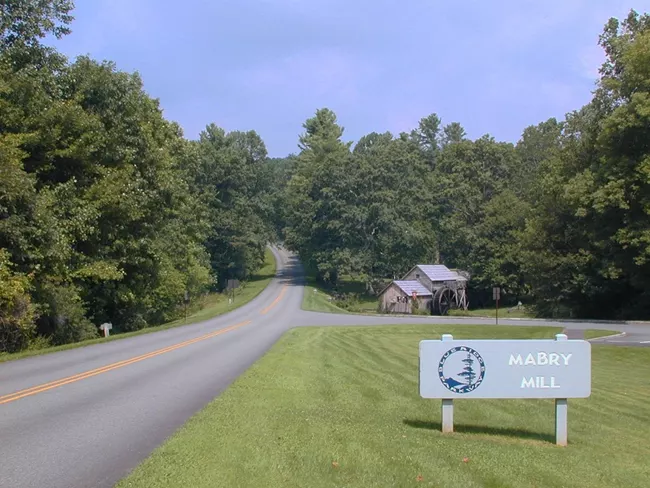The first phase of several projects planned to address needed repairs at the Mabry Mill area, milepost 176.2 on the Blue Ridge Parkway, are set to begin in the coming weeks.
National Park Service staff are finalizing plans for immediate repairs of the mill wheel as the first in a series of phased, planned projects at the site. National Park Service (NPS) Historic Preservation Training Center team members visited the site in December to assess the broken wheel, first discovered in October 2022, and other maintenance needs at the site, including the mill building roof, and pond.
Repairs this summer will address broken sections of the wheel using the current wheel as a template to fabricate and install outer rims and buckets with white oak lumber cut to exact specifications. The wheel axle, spokes and gears appear intact based on site inspections and function of the mill wheel is expected to return as a result of the repairs.
Beyond work that takes place this season, more extensive mill wheel repairs are still needed and being planned. The viability of the mill building, mill wheel, and pond are interconnected, and additional repairs will include pond dredging, mill house roof replacement, and more permanent repairs to the wheel itself.
“Park staff and partners take their role in caring for the Mabry Mill area seriously. We understand that the Mabry Mill area is (and has been) important to the local community for many decades. For this reason, timing and sequencing of the planned projects is critical as we continue federal and philanthropic investments at this very popular park location,” said Blue Ridge Parkway Superintendent Tracy Swartout. “What may appear as bureaucratic delays to the public is an effort behind-the-scenes to ensure that we are good stewards of the site, so that it may serve the public for another hundred years.”
Any federal projects that occur on the Parkway require park managers to review possible impacts to natural and cultural resources. These legal requirements (such as the National Environmental Policy Act, Section 106 of the National Historic Preservation Act, executive orders, and any requirements from the State Historic Preservation Offices) are always considered when undertaking projects in areas like Mabry Mill to ensure protection of these important places for future generations.
Planning and compliance for the dredging and repair of the roof and siding are already underway, and at the same time, the Parkway is working internally and externally to secure funding needed to complete these significant projects.
The Mabry Mill area was purchased by the NPS in the late 1930s, and the mill was restored in 1945 when most of the farm buildings in the complex were relocated to the site. In the 1990s the wheel was completely disassembled and rebuilt. In 2014, the wheel was refurbished with new buckets and outer bands, and in 2018, the mill flume was replaced and new shake roofs installed on historic buildings at the site, with support from private donors and the Blue Ridge Parkway Foundation. Additional preservation work on Matthews Cabin was completed in 2021.
Today, the restaurant and retail operations at Mabry Mill are managed through a concession contract. Services provided by the concession operator have resumed for 2023 and should not be impacted by planned repairs.
The mill grounds and other buildings are primarily staffed by seasonal NPS interpreters and volunteers during the summer months and help to tell the story of life in rural Virginia. The Blue Ridge Parkway Foundation will also sponsor four free mountain music concerts this summer from Jume to September on the second Sunday of each month from 1:00 to 3:00 p.m. ET.
The Blue Ridge Parkway is one of the largest designed landscapes in the country, providing visitors with a wide variety of opportunities to experience southern Appalachian nature, history and culture including over 90 historic buildings, 550 miles of paved road, 900 managed vistas, and thousands of plant and animal species.
The park’s drive-a-while, stop-a-while design enhances the experience; and whether at milepost 0 or 469, driving the scenic route, hiking a trail or taking in a concert or ranger program, Parkway officials remind visitors to have a plan and recreate responsibly. A complete schedule of facility seasons is also available on the Parkway’s website.


